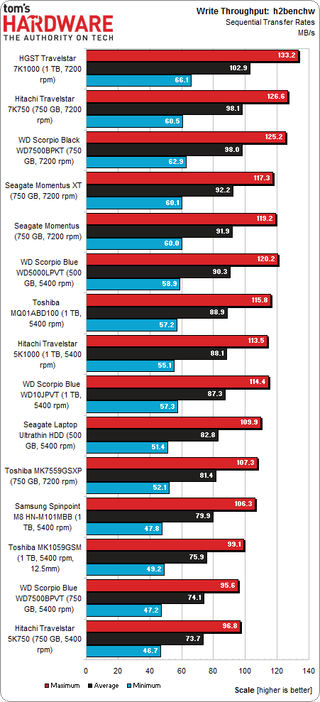Seagate Laptop Ultrathin HDD Review: 500 GB In 5 mm Of Space
When you look at it from the side, Seagate's Laptop Ultrathin HDD is almost easy to miss. Measuring just 5 mm tall, it’s one of the thinnest hard drives in existence. We got our hands on the 500 GB model to see if it can keep up with larger disks.
Results: Sequential Read And Write Performance, And Interface Bandwidth
Our sequential read and write benchmarks put Seagate's Laptop Ultrathin HDD at 84.2 and 82.8 MB/s, respectively. This is actually quite decent performance compared to other 5400 RPM drives, earning it a place in the middle of the pack.
Seagate's performance isn't even close to enough for a competitive shot at the much faster HGST Travelstar 7K1000, which spins at 7200 RPM and hits 133.2 MB/s, though.


Seagate's Laptop Ultrathin HDD makes the best use of its 6Gb/s interface, taking first place in this measure of performance from the data cache across the SATA link. It’s followed closely by Hitachi's Travelstar 5K1000 in second place and the HGST Travelstar 7K1000 in third.

Stay on the Cutting Edge
Join the experts who read Tom's Hardware for the inside track on enthusiast PC tech news — and have for over 25 years. We'll send breaking news and in-depth reviews of CPUs, GPUs, AI, maker hardware and more straight to your inbox.
Current page: Results: Sequential Read And Write Performance, And Interface Bandwidth
Prev Page Laptop Ultrathin HDD Tech Specs And Benchmark System Next Page Results: 4 KB Random Read And Write Performance-
razor512 For the hard drive being benchmarked, is it possible for tomshardware to color the text to make them easier to find in the list?Reply
for example http://i.imgur.com/VXwTs6y.jpg
it only takes about 3 seconds to do (even faster if you are in the process of making the chart and not changing colors in post) -
Someone Somewhere ReplyIts main selling point is the fact that it's only 5 mm thick, instead of the 9.5"
Think you meant 9.5mm there.
At least it's not got proprietary connectors like the WD 5mm ones do. Think you need to add one of those to the benchmarks though - it's Seagate's biggest competition. -
slomo4sho This would be a good choice for a mITX build when you want budget storage to complement a SSD.Reply -
Someone Somewhere Not really; it'll cost significantly more per GB than a 9.5mm drive, but all the bays are fine with the thicker drives.Reply -
slomo4sho Reply11265059 said:Not really; it'll cost significantly more per GB than a 9.5mm drive, but all the bays are fine with the thicker drives.
Regular thickness drives are $60-80 and this one is mentioned to be under $100 with no price given for the consumer market. I wouldn't mind paying a small premium for a drive that utilizes 53% of the area of a 9.5mm drive. -
Someone Somewhere The thing is there's nothing you can do with the extra space; it's a couple of millimeters in the middle of an HDD cageReply -
XngXtuHl No point in 5 mm HDD, any laptop can install regular 9 mm HDDReply
More expensive, more slower
-
Flying-Q Please Tom's, get rid of the new format for pictures having the caption as an alpha-blended banner overlapping the bottom of the picture. This article's second picture, which attempts to illustrate the thinness of the new drive, is ruined by the new captioning method. Use some intelligence and put the caption UNDER the picture. This is the way that has worked for decades in both print and online. Why change something that works for a system that fails?Reply -
Someone Somewhere Reply11265453 said:No point in 5 mm HDD, any laptop can install regular 9 mm HDD
More expensive, more slower
Nope, ultrabooks often have 7mm slots or none, and soon I'd expect that to be 5mm.
Most Popular

